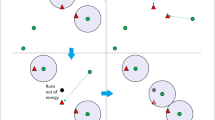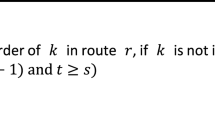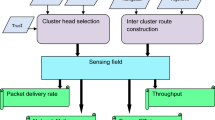Abstract
With the increasing demand for security, building strong barrier coverage in directional sensor networks is important for effectively detecting un-authorized intrusions. In this paper, we propose an efficient scheme to form the strong barrier coverage by adding the mobile nodes one by one into the barrier. We first present the concept of target circle which determines the appropriate residence region and working direction of any candidate node to be added. Then we select the optimal relay sensor to be added into the current barrier based on its input-output ratio (barrier weight) which reflects the extension of barrier coverage. This strategy looses the demand of minimal required sensor nodes (maximal gain of each sensor) or maximal lifetime of one single barrier, leading to an augmentation of sensors to be used. Numerical simulation results show that, compared with the available schemes, the proposed method significantly reduces the minimal deploy density required to establish k-barrier, and increases the total service lifetime with a high deploy efficiency.
Similar content being viewed by others
References
Zhang X, Zhou Y, Zhang Q, Lee V C S, Li M. Problem specific MOEA/D model for barrier coverage with wireless sensors. IEEE Transactions on Systems, Man, and Cybernetics, 2017, 47(11): 3854-3865.
Yang T, Mu D, Hu W. Energy-efficient coverage quality guaranteed in wireless sensors network. Applied Mathematics & Information Sciences, 2013, 7(5): 1685-1691.
Wu F, Gui Y, Wang Z, Gao X, Chen G. A survey on barrier coverage with sensors. Frontiers of Computer Science, 2016, 10(6): 968-984.
Kumar S, Lar T H, Arora A. Barrier coverage with wireless sensors. In Proc. the 11th Annual International Conference on Mobile Computing and Networking, August 2005, pp.284-298.
Tao D, Wu T. A survey on barrier coverage problem in directional sensor networks. IEEE Sensors Journal, 2015, 15(2): 876-885.
Ma H D, Liu Y H. On coverage problems of directional sensor networks. In Proc. the 1st International Conference of Mobile Ad-Hoc and Sensor Networks, December 2005, pp.721-731.
Güvensan M A, Yavuz A G. On coverage issues in directional sensor networks: A survey. Ad Hoc Networks, 2011, 9(7): 1238-1255.
Wang B. Coverage problems in sensor networks: A survey. ACM Computing Surveys, 2011, 43(4): Article No. 32.
Chi K K, Zhu Y H, Li Y et al. Minimization of transmission completion time in wireless powered communication networks. IEEE Internet of Things Journal, 2017, 4(5): 1671-1683.
Yu Z, Chi K K, Hu P, Zhu Y, Liu X. Energy provision minimization in wireless powered communication networks with node throughput requirement. IEEE Transactions on Vehicular Technology, 2019, 68(7): 7057-7070.
Ssu K F, Wang W T, Wu F K et al. K-barrier coverage with a directional sensing model. International Journal on Smart Sensing and Intelligent Systems, 2009, 2(1): 75-93.
He J, Shi H C. A distributed algorithm for finding maximum barrier coverage in wireless sensor networks. In Proc. the 2010 Global Communications Conference, December 2010.
Purohit A, Sun Z, Mokaya F, Zhang P. SensorFly: Controlled-mobile sensing platform for indoor emergency response applications. In Proc. the 10th International Conference on Information Processing in Sensor Networks, April 2011, pp.223-234.
Cheng C F, Tsai K T. Distributed barrier coverage in wireless visual sensor networks with β-QoM. IEEE Sensors Journal, 2012, 12(6): 1726-1735.
Tao D, Tang S J, Zhang H T et al. Strong barrier coverage in directional sensor networks. Computer Communications, 2012, 35(8): 895-905.
Fusco G, Gupta H, Shi H. Placement and orientation of rotating directional sensors. In Proc. the 7th Annual IEEE Communications Society Conference on Sensor, Mesh and Ad Hoc Communications and Networks, June 2010, pp.332-340.
Wang Z B, Liao J L, Cao Q et al. Barrier coverage in hybrid directional sensor networks. In Proc. the 10th IEEE Conference on Mobile Ad-Hoc and Sensor Systems, October 2013, pp.222-230.
Du J Z, Wang K, Liu H, Guo D K. Maximizing the lifetime of k-discrete barrier coverage using mobile sensors. IEEE Sensors Journal, 2013, 13(12): 4690-4701.
Wang Z B, Liao J L, Cao Q et al. Achieving k-barrier coverage in hybrid directional sensor networks. IEEE Transactions on Mobile Computing, 2014, 13(7): 1443-1455.
Ren Y M, Fan X G, Wang H. A distributing scheme for directional barrier coverage enhancing in DSN. Chinese Journalof Sensors and Actuators, 2015, 28(7): 1051-1057. (in Chinese)
Fan X G, Wang C, Yang J J et al. A strong k-barrier construction scheme based on selecting box for directional sensor networks. Chinese Journal of Computers, 2016, 39(5): 946-960. (in Chinese)
Wang Z B, Chen H L, Cao Q et al. Fault tolerant barrier coverage for wireless sensor networks. In Proc. the 2014 IEEE Conference on Computer Communications, April 2014, pp.1869-1877.
Tao D, Ma H D. Coverage control algorithms for directional sensor networks. Journal of Software, 2011, 22(10): 2315-2332. (in Chinese)
Chen J, Zhang L, Kuo Y. Coverage-enhancing algorithm based on overlap-sense ratio in wireless multimedia sensor networks. IEEE Sensors Journal, 2013, 13(6): 2077-2083.
Mohamadi H, Salleh S, Ismail A S. A learning automatabased solution to the priority-based target coverage problem in directional sensor networks. Wireless Personal Communications, 2014, 79(3): 2323-2338.
Mostafaei H, Shojafar M, Zaher B et al. Barrier coverage of WSNs with the imperialist competitive algorithm. The Journal of Supercomputing, 2017, 73(11): 4957-4980.
Mostafaei H. Stochastic barrier coverage in wireless sensor networks based on distributed learning automata. Computer Communications, 2015, 55(1): 51-61.
Mostafaei H, Chowdhurry M U, Obaidat M S. Border surveillance with WSN systems in a distributed manner. IEEE Systems Journal, 2018, 12(4): 3703-3712.
Wang Z B, Chen H, Cao Q et al. Achieving location error tolerant barrier coverage for wireless sensor networks. Computer Networks, 2017, 112(C): 314-328.
Tian J, Zhang W S, Wang G L et al. 2D k-barrier dutycycle scheduling for intruder detection in wireless sensor networks. Computer Communications, 2014, 43: 31-42.
Zhang L, Tang J, Zhang W Y. Strong barrier coverage with directional sensors. In Proc. the 2009 Global Communications Conference, November 2009.
Tao D, Mao X F, Tang S J, Zhang H et al. Strong barrier coverage using directional sensors with arbitrarily tunable orientations. In Proc. the 7th International Conference on Mobile Ad-hoc and Sensor Networks, December 2011, pp.68-74.
Tang F L, Youn L S, Guo S et al. A chain-cluster based routing algorithm for wireless sensor networks. Journal of Intelligent Manufacturing, 2012, 23(4): 1305-1313.
Shih K P, Chou C M, Liu I H et al. On barrier coverage in wireless camera sensor networks. In Proc. the 24th IEEE International Conference on Advanced Information Networking and Applications, April 2010, pp.873-879.
Tao D, Chen H J. Strong barrier coverage detection algorithm for directional field of view sensor networks. Journal of Beijing Jiaotong University, 2010, 35(5): 8-11.
Sung T W, Yang C S. Distributed Voronoi-based selfredeployment for coverage enhancement in a mobile directional sensor network. International Journal of Distributed Sensor Networks, 2013, 9(11): Article No. 165498.
Chang C Y, Hsiao C Y, Chin Y T. The k-barrier coverage mechanism in wireless visual sensor networks. In Proc. the 2012 IEEE Wireless Communications and Networking Conference, Apr. 2012, pp.2318-2322.
Güvensan M A, Yavuz A G. Hybrid movement strategy in self-orienting directional sensor networks. Ad Hoc Networks, 2013, 11(3): 1075-1090.
Ma H D, Li Y, Chen W P. Energy efficient k-barrier coverage in limited mobile wireless sensor networks. Computer Communications, 2012, 35(14): 1749-1758.
Fan X, Chen Q, Che Z, Hao X. Energy-efficient probabilistic barrier construction in directional sensor networks. IEEE Sensors Journal, 2017, 17(3): 897-908.
Zhao L, Bai G, Jiang Y, Shen H, Tang Z. Optimal deployment and scheduling with directional sensors for energyefficient barrier coverage. International Journal of Distributed Sensor Networks, 2014, 10(1): Article No. 596983.
Chen A, Kumar S, Lai T H. Local barrier coverage in wireless sensor networks. IEEE Transaction on Mobile Computing, 2010, 9(4): 491-504.
Wang Z B, Cao Q, Qi H, Chen H, Wang Q. Cost-effective barrier coverage formation in heterogeneous wireless sensor networks. Ad Hoc Networks, 2017, 64: 65-79.
Sibley G T, Rahimi M H, Sukhatme G S. Robomote: A tiny mobile robot platform for large-scale sensor networks. In Proc. the 2002 IEEE International Conference on Robotics and Automation, May 2002, pp.1143-1148.
Xu J, Singh R, Garnier N B, Sinha S, Pumir A. The effect of quenched disorder on dynamical transitions in systems of coupled cells. New Journal of Physics, 2013, 15(9): Article No. 093046.
He S, Chen J, Li X, Shen X, Sun Y. Cost-effective barrier coverage by mobile sensor networks. In Proc. the 2012 International Conference on Computer Communications, March 2012, pp.819-827.
Author information
Authors and Affiliations
Corresponding author
Electronic supplementary material
ESM 1
(PDF 400 kb)
Rights and permissions
About this article
Cite this article
Fan, XG., Che, ZC., Hu, FD. et al. Deploy Efficiency Driven k-Barrier Construction Scheme Based on Target Circle in Directional Sensor Network. J. Comput. Sci. Technol. 35, 647–664 (2020). https://doi.org/10.1007/s11390-020-9210-5
Received:
Revised:
Published:
Issue Date:
DOI: https://doi.org/10.1007/s11390-020-9210-5




